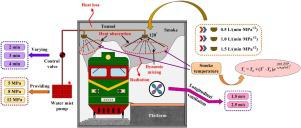当前位置:
X-MOL 学术
›
Process Saf. Environ. Prot.
›
论文详情
Our official English website, www.x-mol.net, welcomes your
feedback! (Note: you will need to create a separate account there.)
Full-scale experimental study on water mist fire suppression in a railway tunnel rescue station: Temperature distribution characteristics
Process Safety and Environmental Protection ( IF 6.9 ) Pub Date : 2021-02-01 , DOI: 10.1016/j.psep.2020.09.019 Chuangang Fan , Rongwei Bu , Xiaoqing Xie , Yang Zhou
Process Safety and Environmental Protection ( IF 6.9 ) Pub Date : 2021-02-01 , DOI: 10.1016/j.psep.2020.09.019 Chuangang Fan , Rongwei Bu , Xiaoqing Xie , Yang Zhou

|
Abstract Rescue stations are essential for emergency evacuation in super-long railway tunnels. However, the deficiency of related studies aiming at improving the fire suppression performance of water mist system in fire scenarios limits its application significantly. In this work, 20 sets of full-scale water mist fire suppression experiments were conducted to examine the impacts of water mist system on smoke temperature characteristics, including water mist activation time (denoted by t), working pressure (P), k-factor (K) and longitudinal wind speed. Results show that when t = 3 min, P = 12 MPa, and K = 0.5, the best performance of temperature control could be achieved. Although there are violent temperature fluctuations in the train side, the smoke temperature could be easily restrained. Moreover, it is found that longitudinal ventilation is helpful to improve the visibility at platform and reduce smoke temperature. When P = 12 MPa, the coupling effect of water mist and longitudinal ventilation on cooling smoke is better. In addition, the non-dimensional maximum temperature rise is found to show a great cubical dependency on vertical height, and decreases along with a larger longitudinal distance for all cases. Also, under longitudinal ventilation, the non-dimensional maximum temperature rises are lower than that without longitudinal ventilation in the coverage area of water mist. Results of this work can provide a significant reference for the design of water mist system in railway tunnel rescue stations.
中文翻译:

铁路隧道救援站细水雾灭火全尺寸试验研究:温度分布特性
摘要 超长铁路隧道应急疏散中,救援站必不可少。然而,针对提高细水雾系统在火灾场景中的灭火性能的相关研究的不足,极大地限制了其应用。在这项工作中,进行了 20 组全尺寸细水雾灭火实验,以检验细水雾系统对烟雾温度特性的影响,包括细水雾活化时间(用 t 表示)、工作压力(P)、k 因子(K) 和纵向风速。结果表明,当t = 3 min、P = 12 MPa、K = 0.5时,温度控制性能最佳。虽然列车侧温度波动剧烈,但烟温可以轻松控制。而且,发现纵向通风有助于提高平台能见度,降低烟温。当P=12 MPa时,细水雾与纵向通风对冷却烟气的耦合效果较好。此外,发现无量纲最大温升对垂直高度表现出很大的立方依赖性,并且在所有情况下都随着纵向距离的增大而降低。同时,纵向通风条件下,细水雾覆盖区域无量纲最高温升低于无纵向通风条件。研究结果可为铁路隧道救援站细水雾系统的设计提供重要参考。细水雾和纵向通风对冷却烟气的耦合效果更好。此外,发现无量纲最大温升对垂直高度表现出很大的立方依赖性,并且在所有情况下都随着纵向距离的增大而降低。同时,纵向通风条件下,细水雾覆盖区域无量纲最高温升低于无纵向通风条件。研究结果可为铁路隧道救援站细水雾系统的设计提供重要参考。细水雾和纵向通风对冷却烟气的耦合效果更好。此外,发现无量纲最大温升对垂直高度表现出很大的立方依赖性,并且在所有情况下都随着纵向距离的增大而降低。同时,纵向通风条件下,细水雾覆盖区域无量纲最高温升低于无纵向通风条件。研究结果可为铁路隧道救援站细水雾系统的设计提供重要参考。细水雾覆盖区域无量纲最高温升低于无纵向通风。研究结果可为铁路隧道救援站细水雾系统的设计提供重要参考。细水雾覆盖区域无量纲最高温升低于无纵向通风。研究结果可为铁路隧道救援站细水雾系统的设计提供重要参考。
更新日期:2021-02-01
中文翻译:

铁路隧道救援站细水雾灭火全尺寸试验研究:温度分布特性
摘要 超长铁路隧道应急疏散中,救援站必不可少。然而,针对提高细水雾系统在火灾场景中的灭火性能的相关研究的不足,极大地限制了其应用。在这项工作中,进行了 20 组全尺寸细水雾灭火实验,以检验细水雾系统对烟雾温度特性的影响,包括细水雾活化时间(用 t 表示)、工作压力(P)、k 因子(K) 和纵向风速。结果表明,当t = 3 min、P = 12 MPa、K = 0.5时,温度控制性能最佳。虽然列车侧温度波动剧烈,但烟温可以轻松控制。而且,发现纵向通风有助于提高平台能见度,降低烟温。当P=12 MPa时,细水雾与纵向通风对冷却烟气的耦合效果较好。此外,发现无量纲最大温升对垂直高度表现出很大的立方依赖性,并且在所有情况下都随着纵向距离的增大而降低。同时,纵向通风条件下,细水雾覆盖区域无量纲最高温升低于无纵向通风条件。研究结果可为铁路隧道救援站细水雾系统的设计提供重要参考。细水雾和纵向通风对冷却烟气的耦合效果更好。此外,发现无量纲最大温升对垂直高度表现出很大的立方依赖性,并且在所有情况下都随着纵向距离的增大而降低。同时,纵向通风条件下,细水雾覆盖区域无量纲最高温升低于无纵向通风条件。研究结果可为铁路隧道救援站细水雾系统的设计提供重要参考。细水雾和纵向通风对冷却烟气的耦合效果更好。此外,发现无量纲最大温升对垂直高度表现出很大的立方依赖性,并且在所有情况下都随着纵向距离的增大而降低。同时,纵向通风条件下,细水雾覆盖区域无量纲最高温升低于无纵向通风条件。研究结果可为铁路隧道救援站细水雾系统的设计提供重要参考。细水雾覆盖区域无量纲最高温升低于无纵向通风。研究结果可为铁路隧道救援站细水雾系统的设计提供重要参考。细水雾覆盖区域无量纲最高温升低于无纵向通风。研究结果可为铁路隧道救援站细水雾系统的设计提供重要参考。











































 京公网安备 11010802027423号
京公网安备 11010802027423号